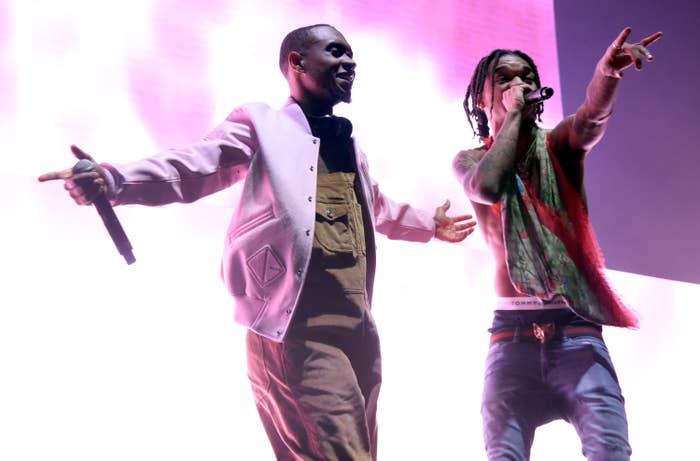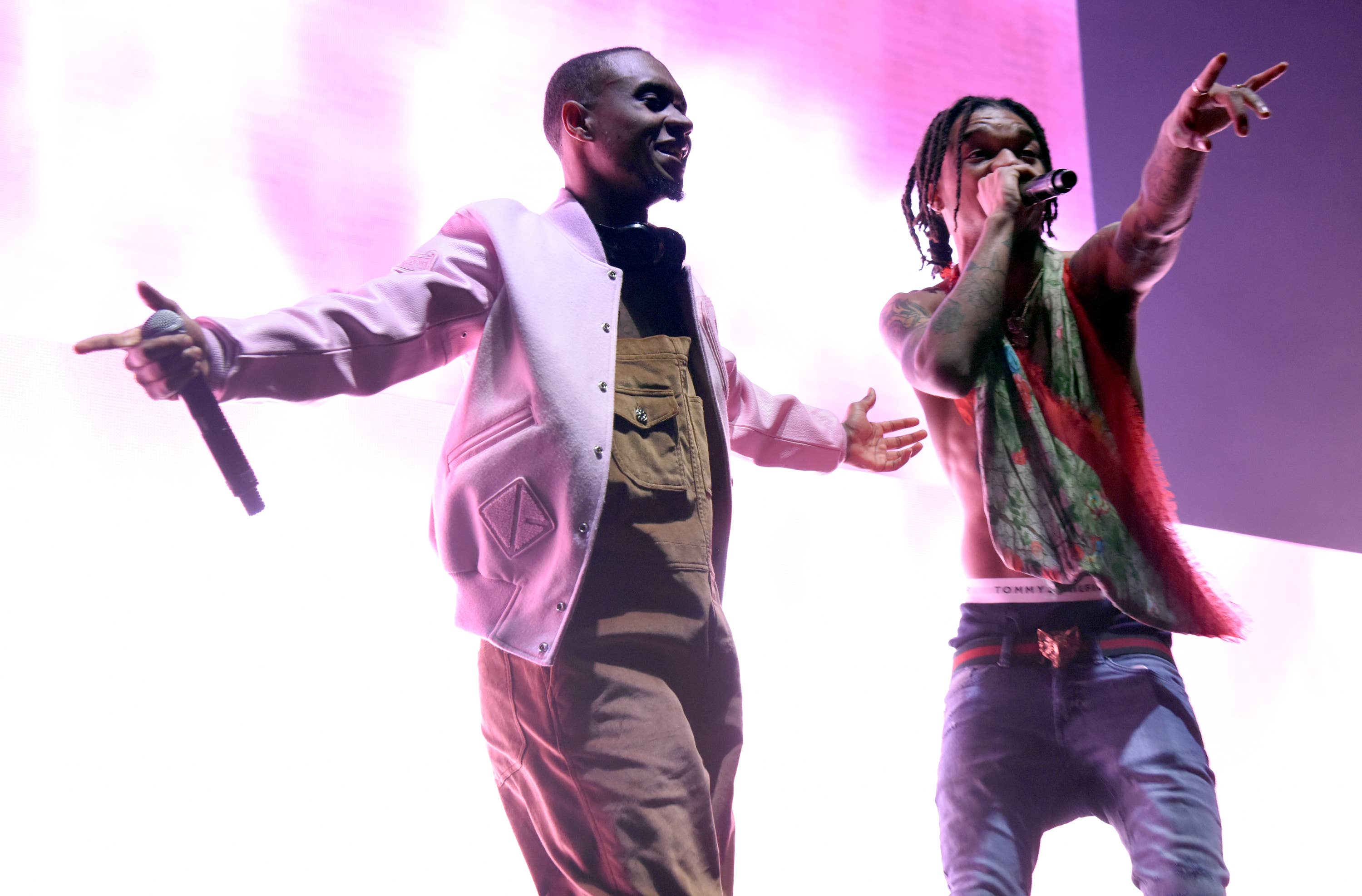
Rae Sremmurd's album Sremmlife 2 came out in August of 2016, but in late October, the third single from the project, "Black Beatles," suddenly spiked because of its ties to the viral #MannequinChallenge. When the challenge started, there was no music associated with it, but as more and more people started uploading videos of themselves frozen in place, "Black Beatles" became the unofficial soundtrack. If you weren't playing the song during your challenge, you weren't doing it right.
By the second week of November, the Gucci Mane-featuring track was the No. 1 song in the country, marking the first time Rae Sremmurd or Gucci Mane had topped the Billboard Hot 100 in the U.S. As this article gets published, "Black Beatles" is still the No. 1 song in the country, and it just hit 50 million streams in consecutive weeks. It's the first time that's been accomplished since Baauer's "Harlem Shake," which was also closely associated with a popular meme.
From the outside looking in, this is one big stroke of luck, but behind the scenes, the team around Rae Sremmurd was facilitating this movement. And while it was ultimately up to the fans to help create their own content and spread it on a massive scale, a few key players were making sure that all the pieces were in place.
With the music industry in a state of constant evolution, successes like this can't always be replicated, but the "Black Beatles" story gives a snapshot of forward-thinking marketing in the music industry of 2016. We spoke with Gunner Safron from Interscope Records and Stoveman and Hobin of Pizzaslime, a popular brand that started as a music blog and evolved to specialize in all things related to internet culture. The conversation gives insight into music marketing in the age of the internet and how a viral moment drove Rae Sremmurd's "Black Beatles" to the No. 1 song in the country.
First off, how did Pizzaslime and Interscope Records end up working together in a professional capacity?
Gunner: When it comes to working with these guys it’s always been about bouncing ideas around and finding ways to make them happen. We’re close friends outside of everything so a lot of our conversations end up being based around new ideas naturally. They influence me all the time but I felt with this campaign specifically they’d be the ones to really nail it. We always talked about wanting to get stuff done together, and it felt like a great fit, just based off the brand they’ve built themselves and the way Rae Sremmurd’s music induces itself into that internet, viral kind of lane. It’s more just about good homies trying to come up with cool shit together. That’s what it felt like.
Pizzaslime: We’ve been trying to find the right project to dive into together, at the right moment. We also have a good relationship with Mike Will [Made It], and so it was just the perfect fit. And with the Rae Sremmurd stuff in particular, the album was rolling out and I had been talking to Gunner, and there seemed to be a disconnect with some of the other companies they were working with on their marketing. So it was just this organic thing that emerged where we were able to connect and build some stuff out. The label was looking for some non-traditional forms of marketing, and that’s what we do best.
The Mannequin Challenge hashtag started finding its way online, and we saw how it was going to build... so it was just about taking “Black Beatles,” knowing that we had a hit song on our hands, and finding ways to associate that song with the Mannequin Challenge.
So Gunner, on your side, was the first time that you had gone out into these non-traditional avenues, or had you been doing that before?
Gunner: I mean, even throughout the past two or three years, we’ve all been leaning towards these non-tranditonal methods. It’s important to have a combination of both. Each artist is different and they need to be treated that way. Pizzaslime has helped me with a lot of things, even for some of the other artists I’ve been working with, just being able to think a little bit left-field when it comes to releasing new content. I think Pizzaslime does a great job at that, and with being able to build a cult following and an audience the right way. Nothing seems traditional. I’ve been able to take some of that stuff and pivot with some of the artists I work with.
For the Rae Sremmurd partnership specifically, I was looking for people to create content for me, I couldn’t find the right people, I had tried to work with a few companies and it just wasn’t working out. So I came back to Pizzaslime and I was like, “Yo, I need your help here, are you guys willing to come on board with this project? I have this idea, and I think you guys could get this shit done.” That was the first time we were able to really come together and build out a campaign. It just felt natural. We had about a month timeline, and we knocked it out.
So Pizzaslime, I know you’ve done brand collabs, but have you ever worked with a major label directly before?
Pizzaslime: Yup. We’ve worked on multiple projects with Dillon Francis and Columbia Records as well as with Diplo and Mad Decent. Those specific projects we really helped build from the ground up but we have also worked with different major labels on random projects. Our work with those labels and other major labels ranges, we’ve done marketing campaigns, art work, art direction, and whatever else they want to throw at us. We’ve also worked with Paramount Pictures on a couple marketing campaigns and creative projects, like Ninja Turtles and Spongebob Squarepants. The Ninja Turtles project was kind of a similar concept to the Rae Sremmurd one, where we came up with an original concept and distributed it strategically to specific influencer accounts.
So can you tell me about the Rae Sremmurd campaign and how that played out?
Gunner: It’s a technique we’re really just starting to use now, but the general idea is taking the approach of new songs, new artists, music in general, and marketing it almost as if I was a music supervisor. Really just trying to pinpoint an audience and figuring out what’s going to drive the music to that audience. It’s different for every artist, and you have to tailor that approach to each one.
With Rae Sremmurd specifically, their music fits so well into memes and short form content right, so the goal was to become the soundtrack to all the things that plug up your timeline. I knew if we could build some momentum by increasing awareness and feeding the right audience we had a shot at this thing taking off. The Mannequin Challenge hashtag started finding its way online, and we saw how it was going to build, and there wasn’t one song that was associated with that when it first came out, so it was just about taking “Black Beatles,” knowing that we had a hit song on our hands, and finding ways to associate that song with the Mannequin Challenge. That’s where we were really successful.
So Mannequin Challenge was already picking up steam before “Black Beatles” became associated with it. Would you say that’s the key, picking up on something that’s organic instead of trying to create something from scratch?
Gunner: I think that was the approach here. We knew we had music, we knew the song was great and the album was great. So our campaign was really built around bringing as much awareness as possible. Once we did that and fed it to the youth, we knew they’d be able to take control. We just had to encourage some of these movements to happen naturally.
By the time I knew what the Mannequin Challenge was, I was thinking, “Oh yeah, that’s the ‘Black Beatles’ thing.” It seemed to happen very quickly. Was it a slower process behind the scenes?
Gunner: Everything just kind of happened perfectly. Slim Jxmmi and Swae Lee saw the [Mannequin] Challenge, they did it at the show that night, it went online, people picked it up, and then it was our job to service it out to as many people as possible and make sure that the association with that challenge was with the music. Everybody from the management, to the artist, to what we were doing on the backend really aligned and it really hit.
“Black Beatles” is now the No. 1 song in the country. Do you think that’s directly because of the Mannequin Challenge?
Gunner: To me, it was going to be a hit. It was going to be a catalog song for them. But there’s no way anything tops the charts as quickly as it did unless you have some sort of viral moment. So you’ve got to give credit to the challenge, but to [Rae Sremmurd’s] credit, they we’re the first artists to do it at their show plus the song is amazing, and at the end of the day the music always speaks loudest. This was really just a vessel for people to hear the music for the first time. I think a lot of our technique is really just trying to find content and build content around the music that’s shareable, which then gives people a chance to discover on their own.
Pizzaslime: Exactly, and just being able to have the senses and ability to pick up on things and feed the beast in the right way.
What do you see as the main challenges with marketing, especially in music, in 2016?
Gunner: To me, the main thing we have to stay away from is this assembly line technique—doing all the same things for different artists and expecting to get the same result—I’m so far from that idea. I think it needs to be tailored specifically to the artist. You can use some of the same ideologies, but you’ve got to be able to pivot and work with the way the artist likes to move. The content needs to be driven through them. We then have to be creative and know to service it.
Pizzaslime: Echoing what you said, I think everything has to be very targeted and specific. There’s no way to emulate the same campaign for every artist—it’s not going to be effective. It’s just about being aware of that and being aware that everything is constantly changing. The same strategy is not going to work, but there are probably elements of past strategies that you can use, but it has to be evolved.
Slim Jxmmi and Swae Lee saw the [Mannequin] Challenge, they did it at the show that night, it went online, people picked it up, and then it was our job to service it out to as many people as possible and make sure that the association with that challenge was with the music.
Do you think labels are falling behind? What you guys did with “Black Beatles” feels like such a forward-thinking strategy, but these kind of viral moments have been heppening for years.
Gunner: I can only speak for this building, but a lot of what we’re doing now is just trying to keep up with the way music streaming is affecting everything. A few years ago, we weren’t necessarily caught up, we were using a lot of the same old formats, but we're beginning to evolve into this new mentality—we’re maximizing everyone’s relationships while keeping close to the culture. You have to find a middle ground, and be able to help build developing artists within a corporate building but also stand close to the culture. I think we do a really good job with that.
A lot of the time when we at Pigeons & Planes first make contact with an artist, it’s before they have a label, before they have a manager, and there’s so much noise right now on social media and the internet in general that it’s really hard to get noticed. What advice would you give to a new artist trying to break through all that noise?
Gunner: To me I think it’s really just about understanding themselves and understanding their audience, understanding the people they’re making music for. Music is in a place now where it’s almost formatted for utility—people have music that they wake up to, or music that they go in the car and listen to with the homies. It’s really about figuring out where your music format is, and then being able to find a route where you can create awareness through those content drivers and reach a larger audience.
How do you handle artists that aren’t so internet-friendly? It seems like a lot of these newer strategies are really dependent on the internet, but do you think there’s a lane for artists who maybe don’t want to be a part of social media? Or are we to a point where that’s essential for any artist today?
Pizzaslime: It seems like it’s something that is essential. It’s a way to connect with people who are interested in you and want to know and learn more about you. You need it to build the foundation. The internet is just a tool to talk directly to your fans or audience. In 10 years, there might be another thing.
Gunner: I think it’s super important for the artists I get to work with. It doesn’t matter how in tune they are, with using it themselves. Every artist is unique in the way that they have conversations with their fans, but it’s an important tool to be able to represent yourself online. There are so many different layers. You don’t need to be the first one online talking about your own music. There are ways to create content, get snippets of music placed. It’s almost like a new format of blogging. A few years ago everyone wanted to get placed on different blogs, and now you want to get on tumblr pages, on Instagram pages, and showcase your work through third parties where you don’t have to be the leader of the conversation. You can allow others to tell the story for you.
you have to trust people like ourselves, or Pigeons & Planes, or whoever. this is what people are doing, this is what kids are looking at. There might not always be hard, analytical data backing that up, but this is what is working.
It seems like everyone wants to make something viral, but when major corporations try to recreate that, immediately kids can sniff it out and tell it’s fake. How important is that balance of trying to reach a lot of people but maintain a level of being organic at the same time?
Pizzaslime: It’s definitely a delicate balance. I think that the most effective is to mix the traditional with the non-traditional approaches. There are things that make sense on both sides, and I don’t think you should be heavy-handed on one side or the other. It depends on the artist. I think that at the end of the day, major corporations are big businesses, and by the time they have something approved and greenlit, it might be a little bit late, and that’s why it feels forced and fake. There are things that we see on the ground that are effective, but there’s not data to prove to the head of whatever at some company that this is an effective method that gives this return and these results. It’s something where it’s a little more fast-paced and you have to trust people like ourselves, or Pigeons & Planes, or whoever. This is what people are doing, this is what kids are looking at. There might not always be hard, analytical data backing that up, but this is what is working.
Gunner: And that’s why it was so important to me to work with Pizzaslime on this project. I knew how quickly we needed this turnaround time to be for us to be effective. I knew it couldn’t be content that we were releasing every other week. It had to be an every day thing. And I knew how quick they were at creating content. And it didn’t need to be content that necessarily gets approved. It’s user-created, we wanted the audience to be a part of creating the content. I think with the listeners that we’re focused on, they’re smart. They feel the authenticity.

